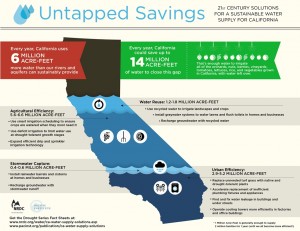NRDC and Pacific Institute Reveal Available Savings of California’s Water Supply to Bridge Worsening Shortage
Published: June 11, 2014
Authors: Pacific Institute and Natural Resources Defense Council
 California could be saving up to 14 million acre-feet of untapped water – providing more than the amount of water used in all of California’s cities in one year – with an aggressive statewide effort to use water-saving practices, reuse water, and capture lost stormwater, according to a new analysis released today by the Pacific Institute and the Natural Resources Defense Council.
California could be saving up to 14 million acre-feet of untapped water – providing more than the amount of water used in all of California’s cities in one year – with an aggressive statewide effort to use water-saving practices, reuse water, and capture lost stormwater, according to a new analysis released today by the Pacific Institute and the Natural Resources Defense Council.
“Our current approach to water use is unsustainable, but that doesn’t mean there isn’t enough water to meet our needs,” said Kate Poole, NRDC senior attorney with the water program. “At a time when every drop counts, we need to employ sensible and cost-effective 21st century solutions that will help us reduce uses today while promising new, resilient supplies for cities and farms tomorrow.”
“As climate change brings more extreme weather, including droughts, ramping up forward-thinking solutions now will help us be more resilient,” said Peter Gleick, president of the Pacific Institute. “With widespread adoption of available water conservation and efficiency improvements, demand can be met more readily, less expensively, and with less pressure on our tapped-out rivers and groundwater basins. Moreover, water reuse and stormwater capture can help boost local supplies.”
NRDC and the Pacific Institute’s issue brief, The Untapped Potential of California’s Water Supply, is a first-of-its-kind statewide analysis examining the significant potential contributions achievable from a combination of improved efficiency in agricultural and urban water use, water reuse and recycling, and increased capturing of local rainwater.
The research also examines the large and growing gap between water use in California and the available water supply. The state suffers from a water deficit in excess of 6 million acre-feet. That amount is unsustainably drawn from the state’s two primary water resources – groundwater and surface waters – each year. On average, the state diverts approximately 5 million acre-feet per year more from the Sacramento-San Joaquin watershed than can be sustained by the estuary, and it overdrafts groundwater by at least 1 to 2 million acre-feet annually. The water deficit is even higher during a drought. Excessive water diversions from the state’s drying rivers and chronic groundwater overdraft have in turn led to shortages for some users, degraded ecosystems, and compromised water quality.
Robert Wilkinson of UC Santa Barbara, report co-author noted, “We have an unprecedented opportunity to do more with less – and we need to take every possible step to do so. By rethinking water management strategies so we work in harmony with the environment and our economy, we’ll be rewarded with dramatic water savings that will offer us local and more sustainable supply for decades to come.”
| Key findings and solutions from the new study include:
– Agriculture uses about 80 percent of California’s developed water supply. Agricultural water users can develop more sustainable water use by expanding adoption of key modern irrigation technologies and practices, such as drip irrigation and precise irrigation scheduling. Some farmers are already employing these practices, which, extended, can reduce agricultural water use by 17 to 22 percent – or 5.6 to 6.6 million acre-feet of water annually. These savings are the equivalent to the surface water that Central Valley farms are lacking this year due to the drought.
–Urban areas use about 20 percent of the state’s developed water supply, much of which is delivered from reservoirs hundreds of miles away at great ecological and energy cost. Improved efficiency, stormwater capture, and greater water reuse can together save a total of 5.2 to 7.1 million acre-feet of water per year, enough water to supply all of urban Southern California and have water remaining to help restore ecosystems and recharge aquifers. These approaches also cut energy use, boost local water reliability, and improve water quality in coastal regions.
–In total, these 21st century water supply solutions can offer up to 14 million acre-feet in new supplies and demand reductions per year, more water than is used in all of California’s cities in a year. These savings would provide enough water to serve 20 cities the size of Los Angeles, every year. |
“While there’s no silver bullet to solving this water crisis, efficiency, reuse, and stormwater provide a tremendous water-saving blueprint we can realize if we take collaborative action now, backed by government and community leadership,” said Poole. “This is a critical moment for all water users to step up and implement robust solutions that will make a lasting difference.”
“We know that traditional water solutions have failed to solve California’s water problems,” said Gleick. “The good news is that there are broad, cost-effective, environmentally sound options that work and that can help us during the current drought and far into the future.”
ISSUE BRIEFS:
SUMMARY: The Untapped Potential of California’s Water Supply: Efficiency, Reuse, and Stormwater (PDF)
Agricultural Water Conservation and Efficiency Potential in California (PDF)
Urban Water Conservation and Efficiency Potential in California (PDF)
Stormwater Capture Potential in Urban and Suburban California (PDF)
Water Reuse Potential in California (PDF)
FACT SHEET: Sustainable Water Future for California (PDF)
 Donate to the Pacific Institute to support and continue our drought work.
Donate to the Pacific Institute to support and continue our drought work.
Sustainably managing California’s water, planning for climate change, ensuring communities have a voice in decision-making, eliminating environmental inequities, supporting a thriving economy and environment: these are the critical challenges of our time. And these are the issues the Pacific Institute researches, influences, and responds to, impacting what happens today – with a vision for the future.

